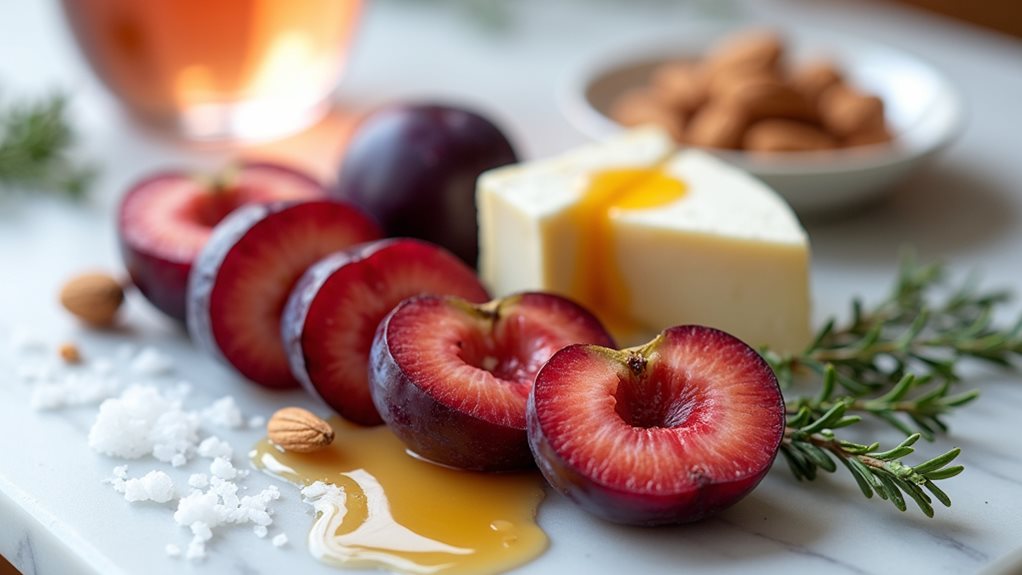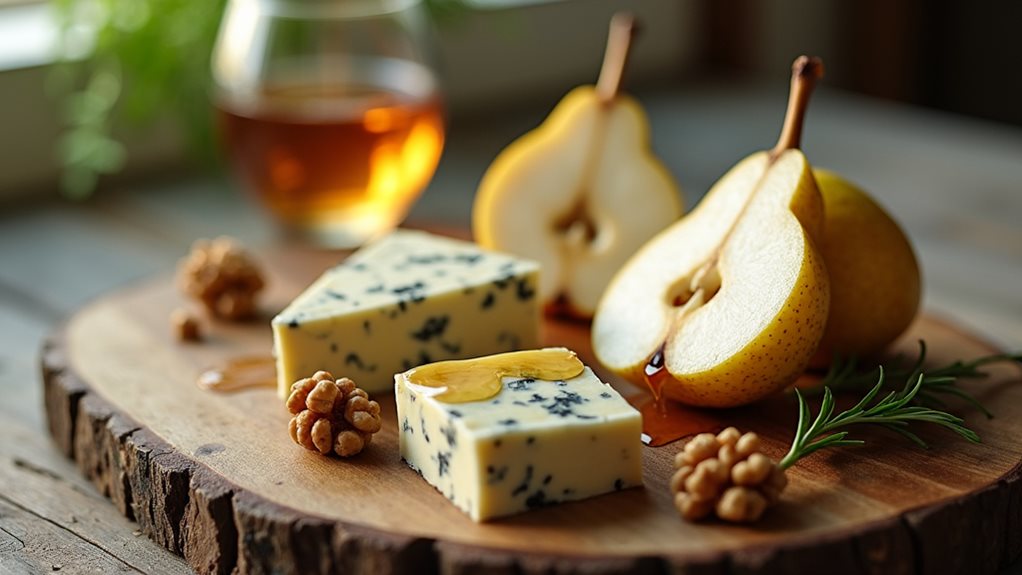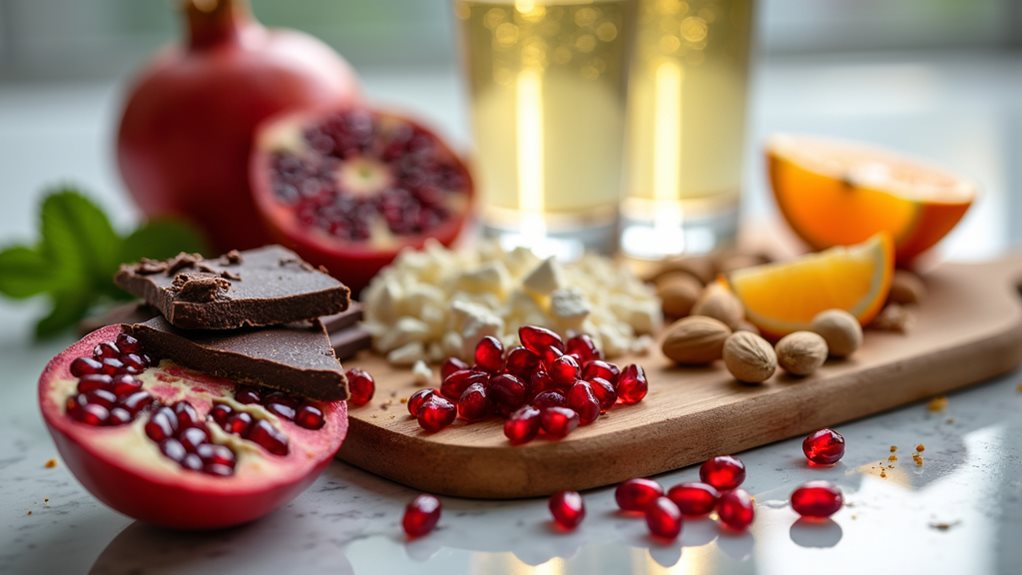Plums pair beautifully with both complementary and contrasting flavors that enhance their sweet-tart profile. You'll find success combining them with other stone fruits like peaches and apricots, or adding warming spices such as cinnamon, cardamom, and star anise. For textural contrast, incorporate nuts like almonds or pecans. Enhance plums further with vanilla, honey, or balsamic vinegar, or create sophisticated beverages using vodka, prosecco, or tequila. These versatile fruits offer countless culinary possibilities waiting to be explored.
The Rich History of Plums in Global Cuisine
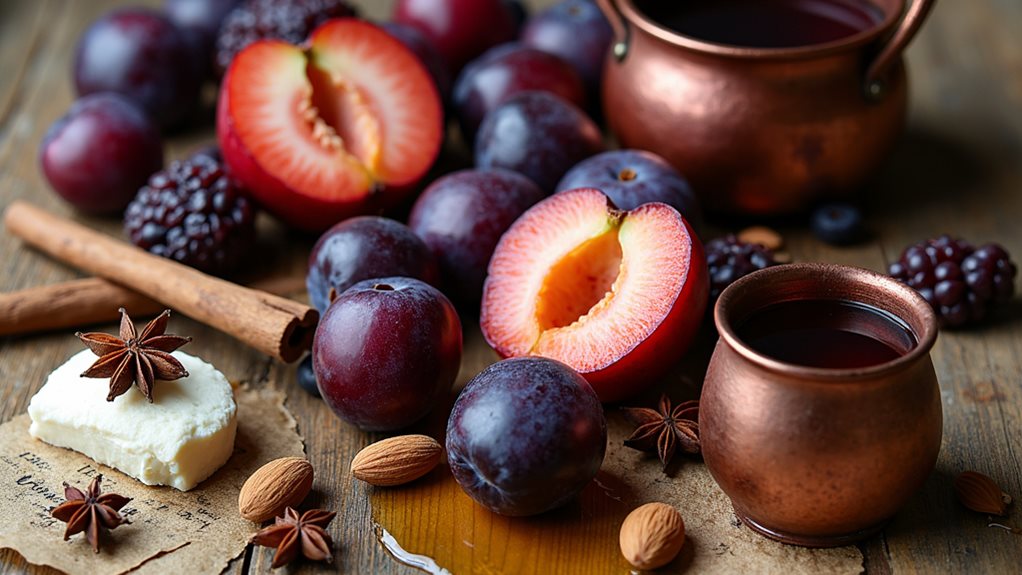
While many modern fruit lovers might overlook plums in favor of more exotic options, these humble stone fruits boast one of the longest and most diverse culinary histories in the world. Dating back to 470 BC in China, plum cultivation has continued uninterrupted since prehistoric times, spreading from its Asian origins to the Caucasus region and eventually worldwide.
You'll find plums deeply embedded in countless culinary traditions – from ancient Tartars and Mongols who relied on dried prunes as a staple food to 17th century American colonists who introduced European varieties to the New World. Luther Burbank revolutionized plum cultivation through his extensive hybridization techniques that produced varieties still popular today. These fruits are recognized for their impressive nutritional profile, containing bioactive compounds like phenolic acids, anthocyanins, and flavanols that contribute to their health-promoting properties.
Their historical significance extends beyond mere sustenance; they've been valued in traditional Indian medicine for treating various conditions and are now recognized for their potential in preventing serious diseases like Alzheimer's and heart disease.
Stone Fruit Companions: Best Fruit Pairings for Plums
When you're looking to enhance your plum dishes, you'll find that other stone fruits create naturally harmonious flavor combinations.
Peaches, nectarines, and apricots complement plums beautifully in both sweet and savory applications, creating classic pairings that highlight their shared juicy characteristics and complementary sweetness levels. Cherries also work wonderfully with plums, as both fruits offer deep, rich flavor profiles that intensify when cooked together.
For more adventurous flavor profiles, try combining plums with citrus fruits like grapefruit or oranges, which add bright, tangy notes that balance the plums' natural sweetness. Consider adding rhubarb to your plum desserts for a delightful tartness that creates a perfect sweet-sour contrast.
Sweet Classic Combinations
Plums naturally harmonize with other stone fruits, creating some of the most delightful flavor pairings in the culinary world. When you're looking to create memorable plum desserts, consider pairing them with peaches for a juicy, sweet combination in pies and crumbles.
Nectarines offer similar complementary flavors, while apricots blend beautifully with plums in homemade jams and preserves.
For classic recipes with depth, try combining cherries and plums in a rustic cobbler—the tartness of cherries balances the sweeter plum notes perfectly.
Don't overlook the less common pairing of pears and plums, which works surprisingly well in both sweet and savory applications.
These traditional combinations have stood the test of time because they enhance plums' natural flavor profile while introducing complementary textures and sweetness levels. The slightly tart undertone of plums creates a perfect balance when paired with sweeter fruits in summer desserts.
Raspberries also make an excellent companion to plums, creating premium dessert bars that are ideal for snacking or serving as an elegant dessert with coffee.
Exotic Plum Medleys
Beyond the traditional pairings, a world of exotic fruit combinations awaits the adventurous plum enthusiast.
You'll discover vibrant colors and flavor contrasts when you blend plums with tropical fruits from global cuisines. Passion fruit puree adds unexpected zing to plum desserts, while mango creates a tropical flair in invigorating salads and smoothies. The Ultimate Fruit Flavor Pairing Chart suggests these unexpected pairings to inspire creativity in your kitchen experiments. Using what's already in your pantry items can lead to surprising and delicious plum-based creations without requiring additional shopping.
- Pair plums with guava for sweet-tangy jams that showcase unique textures.
- Combine with kiwi for tart balance in fusion dishes that surprise the palate.
- Mix with coconut flakes or milk for creamy desserts with tropical spices.
- Blend with avocado for silky-smooth desserts that challenge conventional pairings.
These exotic fruit combinations aren't just visually stunning—they'll transform your plum dishes from familiar favorites to conversation-starting culinary adventures.
Warming Spices That Elevate Plum Dishes
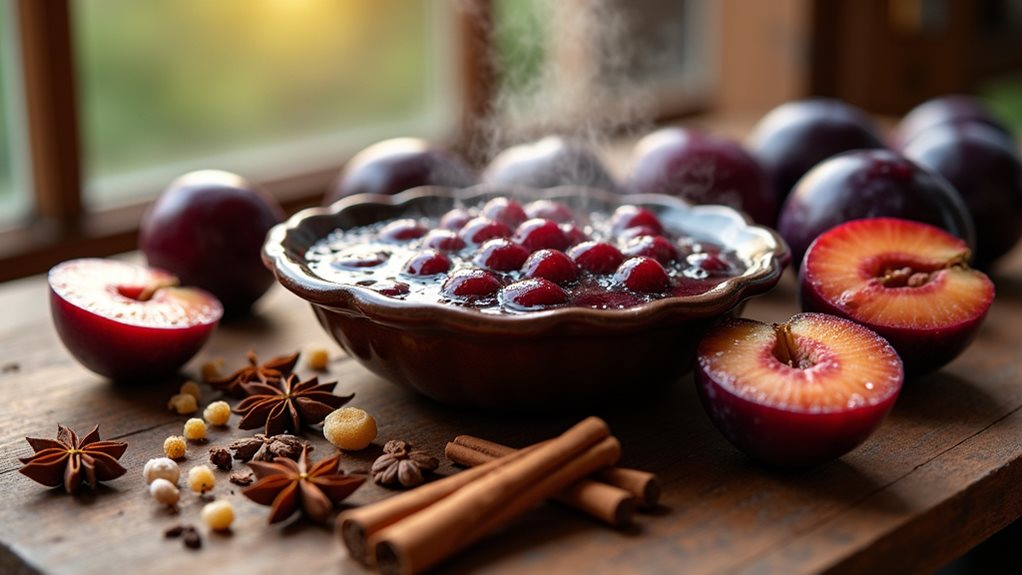
While exploring the world of plum flavor combinations, you'll discover that warming spices provide the perfect counterpoint to the fruit's natural sweetness and tartness.
Cinnamon, ginger, and star anise create complex flavor profiles that transform ordinary plum dishes into extraordinary culinary experiences. These spice combinations work equally well in sweet compotes and savory sauces for meats.
For innovative applications, try balancing nutmeg with allspice in winter plum cobblers, or experiment with cardamom and coriander for a modern twist on traditional recipes. Consider toasting these whole spices to unlock deeper flavors before adding them to your plum dishes.
You'll find these warming elements particularly effective when creating poached plums with star anise or plum chutneys with ginger for cheese boards. The slow cooking process for 15 minutes allows the plums to fully absorb the aromatic spice flavors while softening to the perfect consistency.
Balsamic vinegar adds a wonderful depth and tang to plum dishes, enhancing their natural flavor while contributing rich color to the final preparation.
Consider incorporating sage or thyme when developing savory applications, especially when pairing spiced plums with duck or pork.
Nuts and Seeds: Adding Texture to Plum Recipes
Nuts and seeds transform plum recipes by introducing a satisfying crunch that contrasts beautifully with the fruit's soft, juicy texture.
You'll find that the natural nuttiness enhances plums' sweetness, creating a more complex flavor profile that balances the fruit's natural tartness.
Whether you choose whole nuts for dramatic texture or finely chopped seeds for subtle integration, the combination will add both nutritional value and sensory interest to your plum dishes.
Crunchy Texture Contrast
The delightful contrast between juicy, soft plums and crunchy nuts creates a textural symphony that elevates any plum-based recipe from ordinary to extraordinary.
When you're crafting plum desserts, consider how crunchy toppings can transform the eating experience through contrasting textures.
- Mix almond flour with brown sugar and butter for a gluten-free streusel that crisps beautifully during baking.
- Toast pecans before adding them to your crumble for enhanced nuttiness and extra crunch.
- Layer crushed nuts directly into your plum filling to create textural surprises throughout.
- Experiment with nut alternatives like toasted seeds for unique variations that still deliver satisfying crunch.
The baking temperature and cooling process greatly impact your final texture.
For ideal crunchiness, bake at slightly higher temperatures and allow your creation to cool before serving.
Nuttiness Enhances Sweetness
Beyond their satisfying crunch, nuts and seeds play an essential role in enhancing the natural sweetness of plums through their rich, earthy flavors. The nutty textures of almonds and pecans create sweet contrasts that elevate plum-based desserts to new heights.
You'll find Brazil nuts especially effective when you're looking to add depth to roasted plums, while sunflower and pumpkin seeds provide lighter alternatives with their distinctive flavor profiles.
Try pairing different varieties like Red or Victoria plums with toasted almonds and a hint of vanilla, or experiment with Black Doris plums alongside pecans and cardamom for a more complex taste experience.
Each combination offers not just complementary flavors but also significant nutritional benefits—adding healthy fats, antioxidants, and essential minerals to your plum creations.
For optimal flavor and texture, utilize a kitchen food scale to measure precise amounts of nuts and seeds, ensuring proper balance without adding excessive calories to your plum dishes.
Whole vs. Chopped
When considering how to incorporate nuts and seeds into your plum dishes, you'll quickly face a fundamental question: should you use them whole or chopped? The decision impacts both texture and flavor intensity. Whole nuts create striking visual appeal when garnishing desserts, while chopped nuts integrate more seamlessly, releasing oils that amplify their distinctive flavors alongside plums.
- Chopped nuts distribute more evenly throughout batters and fillings, creating consistent texture in each bite.
- Whole nuts provide satisfying crunch and dramatic textural contrast against soft plum flesh.
- Toast nuts before adding them to enhance their flavor profile, regardless of form.
- Consider your audience—chopped nuts are easier to eat for those with dental sensitivities.
The nut-to-plum ratio remains vital, as excessive amounts of either whole or chopped nuts can overwhelm the fruit's delicate flavor.
The Art of Pairing Plums With Beverages and Spirits
Exploring the world of plum-based drinks opens up a spectrum of flavors that can transform your cocktail experience from ordinary to extraordinary.
Plum cocktails shine when paired with versatile spirits like vodka, which allows the fruit's natural sweetness to take center stage, or tequila, which adds complexity to plum liqueurs in mixed concoctions.
For sophistication, try a Plum Bellini with pureed plums and prosecco in a champagne flute, or experiment with the Golden Plum and Sage Cocktail featuring pisco and honey syrup.
Don't overlook the impact of enhancements like fresh herbs, citrus juices, or a pinch of salt to balance sweetness.
When serving, remember that temperature matters—chilled ingredients preserve the vibrant plum flavor that makes these beverages standout options for brunches and casual gatherings.
Herbal Complements: Fresh Botanicals for Plum Dishes

Fresh herbs transform plum dishes from simple fruit fare into sophisticated culinary creations with complex flavor profiles.
The humble plum, when touched by garden-fresh herbs, blossoms into culinary artistry worthy of the most discerning palates.
When exploring botanical flavor profiles, you'll discover that herbs like rosemary and tarragon create depth while mint and ginger add brightness to your plum-based recipes. Herbal infusion techniques allow you to extract maximum flavor while preserving the delicate balance plums naturally offer.
- Create infused oils with thyme or rosemary for elegant plum salad dressings
- Steep lavender or chamomile in tea to incorporate into plum desserts
- Combine mint and ginger for digestive benefits and zesty flavor in preserves
- Experiment with lemon verbena or basil for unexpected brightness in plum tarts
For innovative combinations, try pairing earthy sage with plums in savory applications or incorporating cardamom for an aromatic twist in sweet dishes.
Sweet and Savory Condiments That Transform Plums
Plums undergo a magnificent transformation when crafted into sweet and savory condiments, elevating them from simple fruits to culinary powerhouses that can enhance nearly any dish.
The versatility of plum variations shines in both Asian-inspired savory sauces and sweet preparations like plum mulberry sauce.
For a classic savory option, combine plums with brown sugar, apple cider vinegar, and aromatic spices like ginger and cinnamon. This sauce pairs beautifully with wontons, egg rolls, and chicken wings.
You'll find the condiment recipes endlessly adaptable—add jalapeños and red onion for a vibrant plum salsa, or blend with soy sauce for a rich meat glaze.
Preserve your creations through water bath canning for 15 minutes, or freeze them for convenient year-round use.
For a delightful breakfast alternative, try incorporating plum preserves into yogurt or as a topping for grain bowls, celebrating their unique flavors similar to roasted root vegetables in their versatility and nutritional benefits.
Seasonal Plum Pairings for Year-Round Enjoyment
Throughout the year, seasonal plum varieties offer unique opportunities to create memorable flavor combinations that showcase this versatile fruit.
Discover endless culinary possibilities as season-specific plums transform ordinary dishes into extraordinary experiences
You'll find that early-season Flavor Supreme Plumcots, with their sweet red flesh, pair beautifully with hazelnuts in summer desserts, while late-season Elephant Heart plums complement duck dishes perfectly for autumn entertaining.
- Try Catalina plums with prosciutto and pistachios for an elegant July charcuterie board that doesn't require complex plum preservation techniques.
- Combine Casselman plums with cinnamon and pecans in August for a simple crumble that highlights mid-season flavors.
- Match Dapple Dandy Plumcots with fresh mint and strawberries for invigorating seasonal plum recipes.
- Pair late-summer Elephant Heart plums with ginger and salmon for a sophisticated dinner option.
Frequently Asked Questions
Can Plums Be Paired With Cheese, and Which Varieties Work Best?
Yes, you'll find plums pair wonderfully with cheese! Try soft plum varieties with creamy goat cheese textures, or contrast tart plums with bold blues. Alpine and soft cheeses also create innovative, mouthwatering combinations.
Are There Any Meats That Particularly Complement Plum Flavors?
The dance of sweet and savory awaits! You'll find pork dishes sing beautifully with plums—their richness embracing the fruit's tartness. Poultry pairings, especially duck, create revolutionary flavor combinations that'll transform your culinary repertoire.
How Do Different Plum Varieties Affect Potential Flavor Pairings?
Different plum varieties impact your pairing possibilities through distinct flavor profiles. Sweet Mirabelles enhance creamy cheeses, tart Damsons elevate savory herbs, while firm Emerald Beauts create textural contrast with nuts like almonds and hazelnuts.
Can Plums Be Used in Savory Sauces for Fish Dishes?
Chef Morimoto's plum-glazed sea bass exemplifies how brilliantly this works. You'll find plums create exceptional savory glazes for fish, especially as a plum reduction that balances sweetness with umami depth in innovative seafood preparations.
What Are the Best Chocolate Types to Pair With Plums?
For plums, you'll find dark chocolate creates a beautiful balance with their tartness. If you're seeking a creamier experience, milk chocolate complements plums' natural sweetness, creating an innovative flavor adventure worth exploring.
Final Thoughts
You've now journeyed through plum's flavor landscape like an explorer mapping uncharted territory. From stone fruit companions to warming spices, each pairing opens a doorway to new culinary adventures. The humble plum, once understood, becomes your canvas for creativity in the kitchen. Don't just cook with plums—orchestrate their flavors, balancing sweet with savory, soft with crunchy. Your palate is waiting for these purple gems' transformation.

